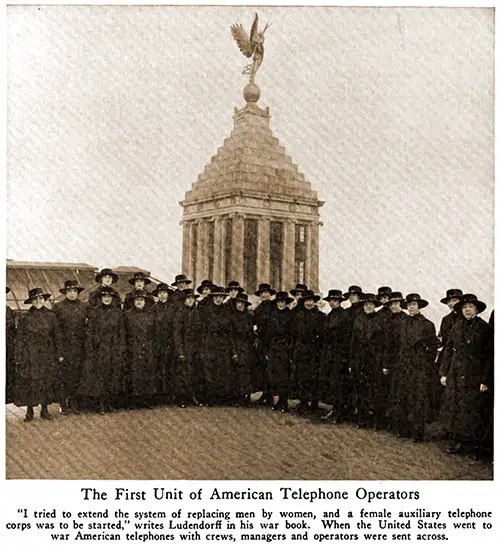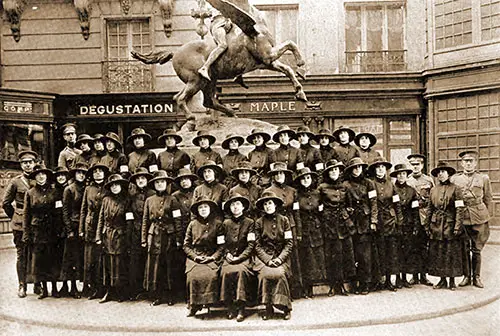First Unit of Telephone Operators Ready for France - 1918

The First Unit of American Telephone Operators. “I Tried to Extend the System of Replacing Men by Women, and a Female Auxiliary Telephone Corps Was to Be Started,” Writes Ludendorff in His War Book. When the United States Went to War, American Telephones With Crews, Managers, and Operators Were Sent Across. Harper's Pictorial Library of the World War, Volume 2, 1920. | GGA Image ID # 18c2fdbc1e
Introduction
The critical role of communication in warfare cannot be overstated, and during World War I, a pioneering group of women stepped into an unprecedented role to support the American military abroad.
The first contingent of American telephone operators, commonly referred to as "Hello Girls," marked a significant chapter in military history. This group of 29 young women, fluent in English and French, was recruited and trained by the Bell System to serve under the Signal Corps in France.
Their unique position as non-combatants, complete with distinctive brassards indicating their rank, highlighted their importance in ensuring seamless communication for General Pershing's forces.
This article sheds light on their recruitment, training, and deployment, showcasing their invaluable contributions during a transformative era for military operations and women's societal roles.
The First Contingent
Twenty-nine young women, including six who have been selected and trained by the New York Telephone Company, have been recruited from all over the country. Along with four others who were not present for the photograph, they will form the first group of telephone operators requested by General Pershing for service in France.
All of these women are fluent in both English and French. They will be assigned to the Signal Corps under the command of Major General George O. Squier, the Chief Signal Officer of the Army, based in Washington. This group will hold a unique position within the American military organization.
The group consists of one Chief Operator, four Supervisors, and twenty-four Operators. Each individual's rank is indicated by a device embroidered on a white brassard worn on the left arm, in compliance with international law, as the operators are non-combatants.
A black telephone transmitter is embroidered on the brassard worn by a Junior Operator. The brassard of a Supervisor displays a laurel wreath below the transmitter, while the Chief Operator's brassard features both the transmitter and laurel wreath, topped with yellow embroidered lightning.

The First Unit of Telephone Operators Trained for Foreign Service by the Bell System. Photograph Taken In France, Where They Have Won the Praise of Secretary of War Baker for Their Efficiency. Their Uniforms Are Dark Blue Serge, With the Letters "U.S." on the Collar. Photograph © Committee on Public Information. The Telephone Review, June 1918. | GGA Image ID # 1982b87dda
The members of the group shown in the above picture are :
- Chief Operator: Miss Grace D. Banker, Passaic, New Jersey
- Supervisor: Miss Jean Cunningham, Westmont, Quebec
- Supervisor: Miss Elizabeth G. Hunter, Medford. Massachusetts
- Supervisor: Miss Renee Mosselin, San Francisco, California
- Supervisor: Miss Minnie R. Richards, Van Buren, Maine
- Operator: Miss Melina J. Adam, Swansea, Massachusetts
- Operator: Miss Eulalie I. Audet, Jamaica Plain, Massachusetts
- Operator: Miss Jean Bouchet, San Francisco, California
- Operator: Miss Almeria Capistran, North Yakima, Washington
- Operator: Miss Estella I. Caron, Brockton, Massachusetts
- Operator: Miss Josephine Davis, New Orleans, Louisiana
- Operator: Miss Cordelia Dupuis, Rolla, North Dakota
- Operator: Miss Sara Fecteau. West Lebanon, New Hampshire
- Operator: Miss Marie L. Ford, Worcester, Massachusetts
- Operator: Miss Esther V. Fresnel, New York City
- Operator: Miss Marie A. Gagnon, Grafton, North Dakota
- Operator: Miss Charlotte M. Gyss, Yonkers, New York
- Operator: Miss Winifred Hardy, Montreal. Canada
- Operator: Miss Leontine G. Lamoureux, Lowell, Massachusetts
- Operator: Miss Rose Langelier, Lynn, Massachusetts
- Operator: Miss Marie A. Le Blanc, Montreal. Canada
- Operator: Miss Louise Le Breton, San Francisco, California
- Operator: Miss Raymonde Le Breton, Berkeley, California
- Operator: Miss Minerva G. Nadeau, Boston, Massachusetts
- Operator: Miss Helen A. Naismith, Seattle, Washington
- Operator: Miss Frances Bigelow Paine, Bronxville, New York
- Operator: Miss Bertha Plamonden, San Francisco, California
- Operator: Miss Suzanne Prevot, New York
- Operator: Miss Georgette Schaerr, Omaha, Nebraska
- Operator: Miss Agnes M. Theriault, Presque Isle, Maine
- Operator: Miss Fernande J. Van Balkom, New York
- Operator: Miss Alice Ward, Montreal, Canada
- Operator: Mrs. Clara Whitney, Butler, Pennsylvania.
Conclusion
The deployment of the first unit of American telephone operators to France in 1918 exemplifies how technological advancements and skilled personnel can change the course of military operations.
These women's fluency and expertise bridged critical communication gaps in wartime. They laid the groundwork for recognizing women's capabilities in traditionally male-dominated fields. Their professionalism and efficiency earned praise from leaders like Secretary of War Newton Baker, affirming their vital role in the success of the American war effort.
This pioneering group exemplified the evolving nature of warfare. It carved a path for future generations of women to contribute significantly to national and global causes.
"The First Contingent," in The Telephone Review, Vol. 9, No. 3, March 1918, p. 74.
